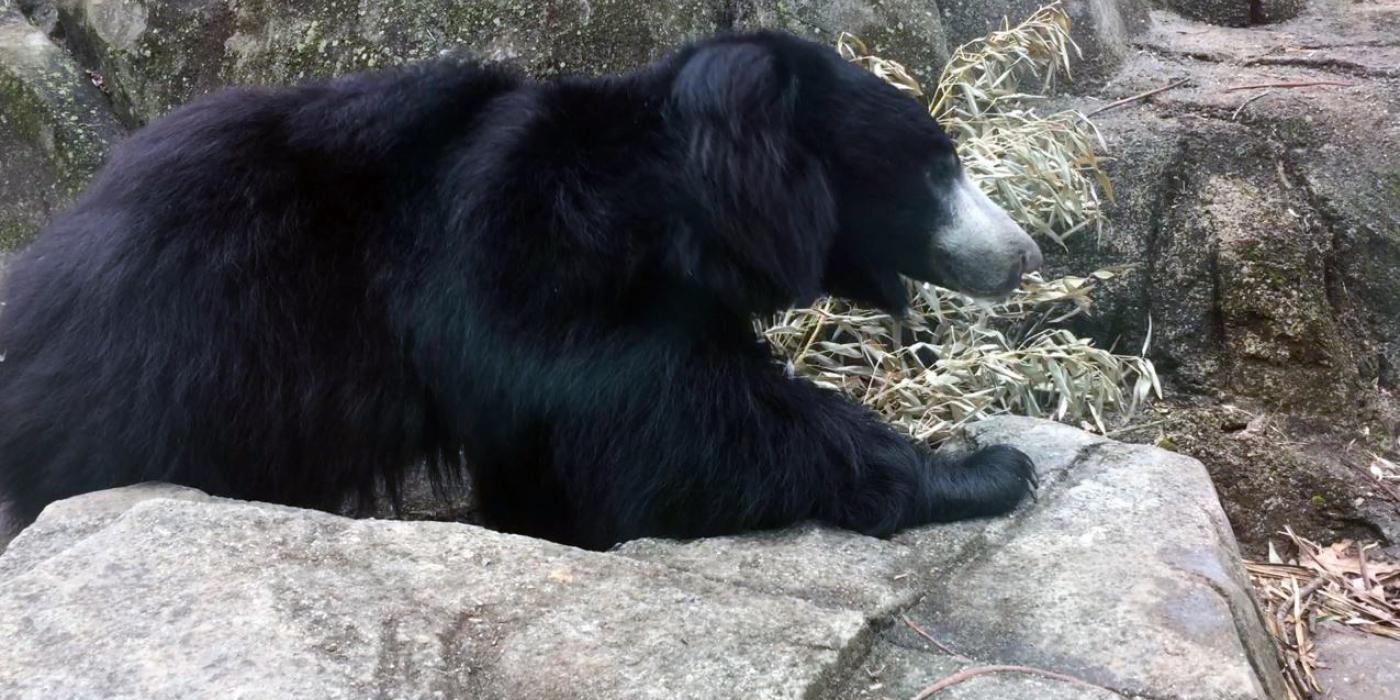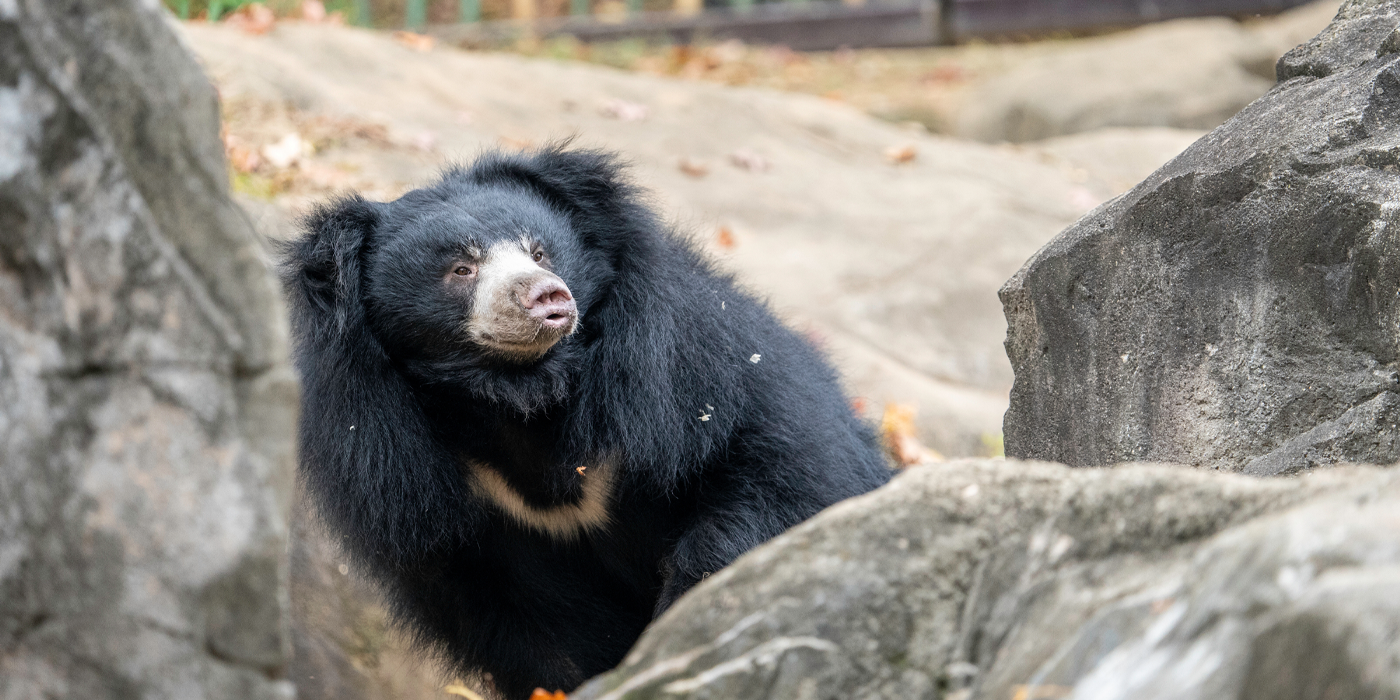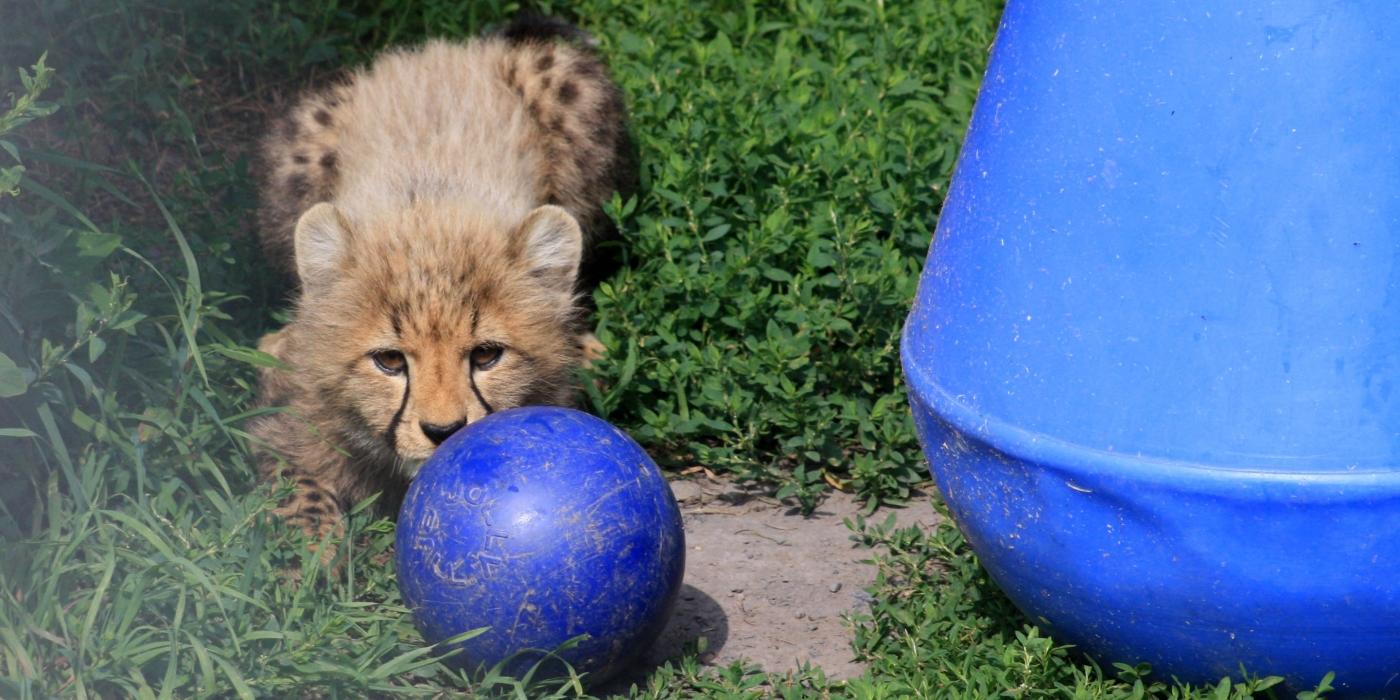New at the Zoo: Sloth Bear Niko
Get the scoop on the Zoo’s new 3-year-old sloth bear, Niko, from animal keeper Mindy Babitz.
What is Niko’s personality like?
Niko is a big goofball! He is very silly and creative when he plays with toys. We have seen him lay on his back while kicking a bouncy hanging toy with his feet, placing a traffic cone over his head and walking around bipedally. He makes us laugh every day.
Niko is also very laid-back and calm. Most sloth bears tend to be nervous and reactive to sounds or sights that startle them, but he is very even-tempered. Niko will confidently approach or examine a situation before deciding whether to react or not. His calm and confident personality has made the acclimation process and introductions with his companion, Remi, very smooth.How are Niko and Remi getting along?
Our bear pair have lived together for two months. From the get go, Niko was very excited to meet Remi. He spends most of his time following her around and rarely ventures too far from her. Remi likes to take new relationships slowly. For the most part, she seems to enjoy Niko’s company and is not afraid to put him in his place or lay down the rules before she plays with him. This has all been a learning experience for Remi, but once she realized Niko would back off when she “asked” him, she became more agreeable to having a companion.
Sloth bears are native to India, Sri Lanka and southern Nepal, so it is often too chilly for them to go outside in winter. Now that warm weather is in the forecast, Niko and Remi are much more active and can be seen playing together in the yard. Often, Remi will lead Niko on chases around the yard or playfully swat at him from behind a tree or rock. Sometimes, they will go off and explore one or both habitats on their own.
What are Niko’s favorite activities?
We provide a wide variety of enrichment to our sloth bears, including puzzle feeders for foraging, boxes and bags for shredding, sheets and hammocks made of firehose for naps and resting, as well as natural items like rotting logs and sticks. His favorite toys are boomer balls and bobbins that we hang from the ceiling of his indoor enclosure using garage door springs or heavy duty bungees. He will pull on the toys and box them around. Since they are on springs, they bounce right back!
Has Niko participated in training?
We started daily training sessions with Niko as soon as he arrived in quarantine. He enthusiastically participates and seems to enjoy the one-on-one attention he receives from keepers, especially. It is extremely helpful to the animal care team that he knows behaviors that help us evaluate his health, but it also makes a visit from the vet less stressful for him.
We use positive reinforcement training with our sloth bears, which means that they always have the choice to participate in their own care. If they do, we give them a reward—usually a piece of their favorite food along with lots of verbal praise from their keepers.
Niko has learned a number of basic husbandry behaviors, such as opening his mouth so we can look at his teeth, standing up so we can see his belly, and putting his front and back paws on the mesh so we can monitor the condition of his foot pads. All of these behaviors help us to get a good look at him and ensure he is healthy and does not have any injuries.
Niko has also learned a number of complex medical behaviors such as leaning against the mesh for a voluntary injection or extending his arm out of the enclosure and into a sleeve for voluntary blood draws. The more complex the behavior, the bigger the treat! For medical behaviors, which can take more time and patience to master, he gets something very special, such as honey or peanut butter.
What is your favorite fact about sloth bears?
Sloth bears are built specifically for sucking up insects; they have a long muzzle, floppy lips, a nose flap that can close, a concave palate, and their two front top incisors missing. In the wild, these bears “vaccum” up approximately half a million termites a day! Termites and ants make up the majority of their diet in the wild, but they will supplement that with fruit when it is in season. To help keep the bugs from biting them, sloth bears have a long, shaggy coat that consists of what we call “guard hairs.” They do not have the undercoat that other species of bears have.
When will we see sloth bear cubs at the zoo?
Niko and Remi will receive a recommendation to breed from the Association of Zoos and Aquariums’ Species Survival Plan (SSP). Both Niko and Remi are sexually mature at three and four years old, respectively. However, they are still quite young and may or may not breed this year. In human years, they would be in their early teens.
Sloth bears typically breed between May and July. We are cautiously optimistic that they will breed and are keeping our fingers crossed for a cub or two. The likelihood, however, is that it will be a couple of years before Niko and Remi produce cubs.
What is the best time to see Niko and Remi on exhibit?
Remi and Niko tend to be most active just after we place enrichment items around their yard, between 8 and 10 a.m. and 3 to 6 p.m. Typically, they will explore both of their yards and are good at hiding in the bamboo or in their caves. Look carefully and be patient in trying to spot them. When they are active, they move around a lot (unlike a sloth), so if they have gone inside for a bit, they will be back out shortly. You might also catch them resting in a cave between 10 a.m. and 1 p.m. taking their midday nap.
The daily “Meet a Sloth Bear” demonstration is another great way to see them and catch a glimpse of our training sessions. That takes place at 1:30 p.m. on Sundays, Mondays, Tuesdays, Fridays and Saturdays; and at 1:45 p.m. on Wednesdays and Thursdays. Be sure to check out the Daily Programs calendar for the most up-to-date information when you plan your visit.
This story was featured in the April 2018 issue of National Zoo News.
Related Species:




